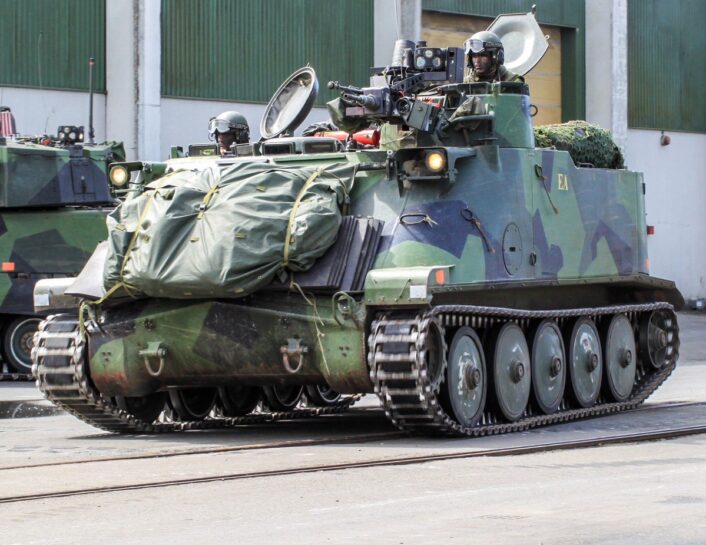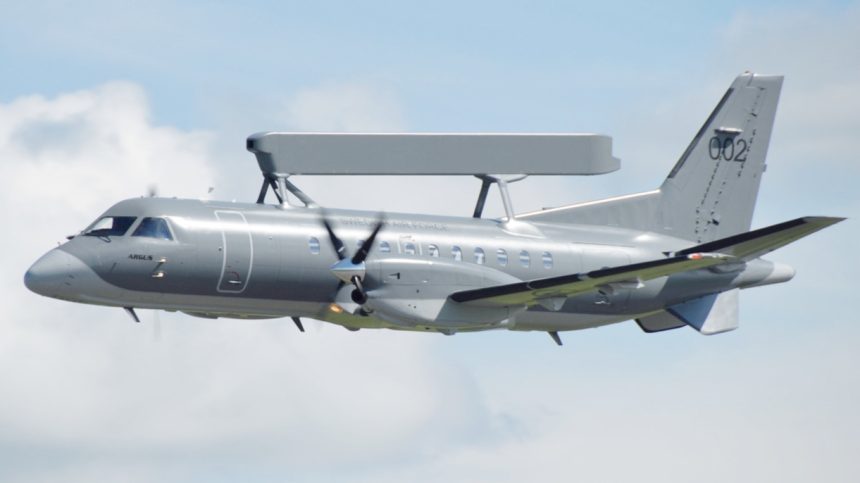The two Saab 340B AEW&C aircraft are part of a $1.3 Billion military aid package announced by Stockholm.
In one of the most interesting military aviation donations to Ukraine since the war began in February 2022, Sweden has announced sending its Saab 340B AEW&C (Airborne Early Warning and Control) aircraft to Kyiv, as per an announcement made by its defense ministry on May 29, 2024.
The aircraft (designated S100D/ASC890 by the Swedish military) are part of a larger military aid package worth 13.3 billion Krona ($1.3 billion) that also consists of land systems like armored carriers, artillery ammunition and “resources for maintenance of previously donated material,” Defense Minister Pål Jonson said.
ASC 890 will provide 🇺🇦 with a new capability against both airborne and maritime targets. 🇺🇦 capability to identify targets at long range will be strengthened. They will act as a force multiplier with the introduction of F-16. AMRAAMs will also be donated. (2/6)
— Pål Jonson (@PlJonson) May 29, 2024
The package also comes after Stockholm formally joined NATO (North Atlantic Treaty Organization) in March 2024, followed by Finland in April. Interestingly, Sweden declared the ASC890 and the military aid the same day as it “paused” its “plans” to send Saab Gripen fighters to Ukraine, “in order to allow for the induction of F-16 fighter jets,” Reuters reported.
Stockholm had been considering Kyiv’s request for the jets since last year. “We have been urged by the other countries in the coalition to wait with the Gripen system,” Defence Minister Pal Jonson told TT. “This has to do with the fact that the focus is now on introducing the F-16 system,” Jonson said.
ASC890 Will Boost Surveillance
According to Jonson, the ASC (Airborne Surveillance Control) 890 will lend a “military capability” that will “strengthen Ukraine’s air defense.” Called “Package 16,” it will be the “largest Swedish military aid package at Euro 1.16 Billion. ASC890 will provide Ukraine with a “new capability against both airborne and maritime targets.”
“The donation will entail a temporary decrease of Sweden’s defence capability, which will be addressed by procuring additional S 106 GlobalEye aircraft and advancing previous orders for two new GlobalEye aircraft,” a statement said.
The ASC890 Erieye is the name of the airborne radar system, mounted on the Saab 340B twin-engine turboprop aircraft. The overall system is called the Saab 340B AEW-300/S 100D Argus. It is an AESA (Active Electronically Scanned Array), which allows for dynamic adjustment of radar emission, to cover a wide area or focus on a smaller prioritised zone. With rapid and precise object detection and tracking capabilities, the radar boasts a high update rate, while the S-band mode ensures performance in a range of weather conditions.
Its effective surveillance range spans over 500,000 square kilometers horizontally, and extends vertically to more than 60,000-feet. The system’s sea coverage is unrestricted enabling the detection and tracking of objects including fighter aircraft, hovering helicopters, cruise missiles, and even sea targets as small as jet skis.
By the way, although AWACS is the name of the specific system installed in the E-3 and Japanese Boeing E-767 AEW&C airframes, it is often used as a general synonym for AEW&C.
How Will it Help Ukraine?
The radar will go a long way in detecting long-range Russian standoff missile fires like Kh-101 ALCM (Air-Launched Cruise Missile), Iskander and Iskander-M tactical battlefield missile and possibly the Kinzhal aero-ballistic hypersonic missile that are often fired deep behind Ukrainian frontlines or into its cities. It is unlikely it will be used to support fighter operations closer to the frontline since it is limited in number and would be easily vulnerable to long-range Russian AAM (Air-to-Air Missiles).
Early detection of fast maneuvering missiles like the Kh-101 or the Kh-69 (X-69) that are programmed to change directions throughout their journey can take the load of other larger radar systems like the Patriot PAC-3, NASAMS or the German IRIS-T. An additional set of eyes from an airborne radar can help prioritize targets in an integrated network by coordinating with the ground radars.
Moreover, that the ASC890/Saab 340 comes before the arrival of the F-16, means the AWACS will have a role to play in the fighters’ scheme of things. This could possibly be detecting Russian missiles and projectiles heading towards the Ukrainian air bases hosting the jets. Russia had announced it would strike NATO air bases in Ukraine’s neighboring countries as “legitimate targets,” if the F-16s took off from there.
This leaves only air bases within Ukraine for the F-16s to fly from, which Russia is likely to target first in massive missile strikes. The Swedish AWACS can fly from close to western and northwestern Ukraine to detect possible Russian land-strike missiles before the F-16s take off. Moreover, Russia also uses vessels from its BSF (Black Sea Fleet) to fire Kalibr cruise missiles and P-800 Onyx coastal defense missiles to hit land targets around Odessa and southwestern Ukraine. These too can be observed more closely.
Currently, only NATO E-3 Sentry AWACS, RC-135 Rivet Joints, drones like the MQ-9 Predator and the MQ-4 Global Hawk, and very few other assets provide radar and ELINT (Electronic Intelligence) cover to Ukraine. They fly just outside its territory from Europe, as flying over Ukrainian airspace over the battlezone will make them legitimate targets. The fate will be the same if they enter Russian airspace around occupied Crimea, limiting their flights to the Ukrainian and southern part of the Black Sea.
These aircraft help Ukraine collect a lot of data on Russian ground radar placements before its UAV and Storm Shadow ALCM strikes into Russia’s rear or in Crimea. Being a Western platform, the ASC890 can integrate seamlessly with the above NATO aircraft and ease this process.
It remains to be seen whether it will be manned by Ukrainian personnel or Swedish. Given the urgency of the platform and the time required for training, it is likely Swedish crews will operate the plane. There are also chances that to prevent the destruction of the ASC890 on the ground itself, European and Ukrainian planners would be considering operating it from NATO air bases just outside Ukraine.
Other Swedish Weapons
Beside the ASC890, Sweden will also donate the AMRAAMs (Advanced Medium-Range Air-to-Air Missile). These will possibly either be installed on the F-16s or the NASAMS (National/Norwegian Advanced Surface-to-Air Missile System). These “can be used on aircraft and in ground-based air defence systems. The missiles will be redesigned to suit ground-based anti-aircraft systems,” the statement added.
Sweden also admitted that the donation “will entail” a “temporary decrease” of its “defence capability, which will be addressed by procuring additional S 106 GlobalEye aircraft and advancing previous orders for two new GlobalEye aircraft.”
Other systems donation include its “entire stock of armoured tracked personnel carriers (PBV 302) to support the reconstruction of new Ukrainian brigades,” and “artillery ammunition and resources for maintenance of previously donated materiel.”

Sweden will also deliver “surplus tank vehicles,” “maintenance of previously donated Swedish materiel, financial support to capability coalitions and to funds and temporary initiatives to enable swift and large-scale procurement of material to Ukraine.”
The Swedish Defence Research Agency will also be tasked with supporting Ukraine in establishing its own defence research institute. Furthermore, Ukraine’s command and control capability will be strengthened in the package through a donation of terminals with subscriptions for satellite communications.









